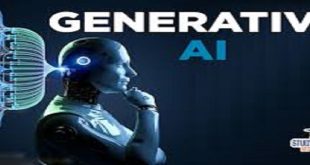The Rise of Generative AI: A New Generation of Creativity and Innovation
In the last couple of decades, few fields have been able to evolve at an astonishing rate like that of Artificial Intelligence. The rise of generative AI, however, has been more exciting and revolutionary than perhaps any other development in the field.
Whereas traditional AI typically classifies records, makes decisions, or identifies patterns solely based on existing information, generative AI seeks to create it. Whether text, images, music, or perhaps entirely immersive experiences, generative AI opens doors to creativity, innovation, and problem-solving not there before.
From leading-edge language models, such as OpenAI’s GPT series, to photogenerating technology including DALL-E and MidJourney, generative AI is impacting industries as many as healthcare, leisure, fashion, advertising and marketing, and greater.
In this text, we shall discover the standards at the back of generative AI, its packages, the ethical issues it increases, and its potential to reshape the destiny.
What is Generative AI?
Generative AI is used to refer to algorithms that can create new content by learning from data. Such models learn styles in a way that they would be able to create something new. In other words, the objective here is to have algorithms that could replicate human creativity through the creation of something sensible, often not differentiable from human-made products.
These include deep learning and neural networks at the heart of generative AI. Most generative AI systems adopt architectures such as GANs, Variational Auto-Encoders,
or Transformer-based models. GANs are especially remarkable for their dual-model structure in which one network generates content-the generator-and another network criticizes it-the discriminator. This feedback loop forces the generator to deliver ever more convincing output.
While VAEs compress records directly into a latent space from which new outputs are reconstructed by sampling from this space, transformer models, such as GPT, generate coherently and contextually relevant texts through processes that capture relationships between sequences of words or images.
Applications of Generative AI
Generative AI has found utility in an ocean of fields, each pushing the envelope of what is possible.
1. art and design
Perhaps the most immediate and visible consequence of generative AI has been within the creative industries themselves. Artists and designers are taking advantage of generative AI tools in making visual arts, music, and even immersive digital universes.
Models like DALL-E- and Midjourney-like enabled users to make complex images out of simple text prompts, which in turn gave way to completely new forms of creative expression. Collectively, AI can create original sections or work with human artists to provide hybrid pieces that integrate human and machine contributions.
two. Healthcare
Generative AI has immense potential for personalized medicinal drugs within healthcare. It helps study huge datasets of medical pictures, patient histories, and genetic information that yield predictive models to assist the physician in more accurate diagnoses.
For example, generative models can simulate the progress of diseases or predict how a patient may react to a particular treatment. This could lead to even more focused and effective health-care solutions.
Generative AI can also be applied to the process of drug discovery. Traditional methods of finding new medicines may take years and cost billions of dollars. By utilizing generation capability, the same molecular structure, which will interact with specific organic targets, can significantly speed up the process of developing new medicine.
3. Entertainment
The entertainment enterprise has utilized generative AI to build greater immersive stories. In video games, AI will be able to create dynamically generated characters, environments, and storylines that make video games more responsive and tailored to character gamers.
The characters and scenarios generated through AI are becoming more real, which increasingly raises the level of intensity and complexity of the interactive narrative.
AI-generated track and scripts also slowly find their way into movies, TV, or even live performances. While the human touch remains pivotal for depth in emotion and creativity, AI tools are starting to become invaluable in extending what creatives can do.
4. marketing and content creation
Generative AI is rewriting the rules of the marketing game by empowering teams to deliver personalized content at scale. For example, chatbots augmented with generative AI can interact with your customers in dynamic, context-sensitive dialogues, while AI-driven content creation tools will help marketers create blog posts, social media updates, product descriptions, and ad copy a lot faster.
Generative AI also finds its use in product diagram and branding. That could be in diagramming the logos, creating product mockups, or even enhancing adverting and marketing techniques completely based on insights gathered from data.
5. style
Generative AI also finds its place in the fashion industry for creating specific designs, predicting trends, and optimizing delivery chains. Fashion designers will also be able to use AI when coming up with new styles and patterns that are aesthetically pleasing yet viable to make.
Additionally, AI can analyze customer behavior and choices to help manufacturers predict demand more precisely, reduce waste, and make sure collections strike a chord with consumers.
Moral Issues and Demanding Situations
While the potential blessings of Generative AI are huge, it also brings about crucial ethical questions and demanding situations. As these systems become more powerful and larger, issues about misuse, misinformation, and intellectual property have come to the fore.
1. Deepfakes and Misinformation
One of the hotter topics involves the use of generative AI for creating forged or misleading content-what some people call deepfakes. Using AI to manipulate moving images, photos, or audio tracks, bad actors can create convincing content that is nonetheless completely fabricated.
This has serious implications for privacy, safety, and faith in media, given a backdrop of political misinformation and cybercrime.
The capability for generating deepfakes has already been used to spread disinformation and malware, defame individuals, or even manipulate the stock market. This would become even more complex to contain sham or malicious material with more advanced generative AI; it would definitely require technological, legal, and regulatory solutions.
2. Intellectual Property and Copyright
Another ethical issue is one of ownership and copyright. If a generative AI creates something-a work of art, a melody, a writing-to whom does it belong: the original creator of the AI, the originator of the material created, or no one at all?
It becomes even more convoluted when the AI has been trained on existing copyrighted material, which begs questions concerning whether newly generated content is derivative or completely original.
many lawsuits were filed related to AI-generated works, with courts scrounging for how to grant highbrow assets rights in a manner that balances innovation with protection for the human creators.
Bias in AI-Generated content
Bias in AI is well-remarked, and generative AI is no exception. Considering these models are normally trained on existing data, they tend to propagate and even amplify a lot of the biases prevalent within that data.
For example, AI-generated content may also happen to reflect racial, gender, or other cultural biases entailing discriminatory consequences.
Bias overriding requires not only purely technical solutions that involve increasing the diversity of training data, but also social awareness to make the content generated by AI inclusive and non-discriminatory.
In any case, ensuring that AI is free from bias is a process that takes time and requires constant attention by developers and regulators alike.
Future of Generative AI
As generative AI continues to develop, its potential to reshape industries and enhance human creativity is immense. Its future, though, may be determined by how well society can navigate the ethical and criminal challenges that it presents.
Addressing this will require collaboration across governments, technology companies, and civic society to provide guidelines and frameworks that help foster responsible AI development.
The future of generative AI can be a lot more in collaboration with humans where AI assists or co-writes rather than displaces human effort. For example, in creative domains, AI will help artists and writers push the boundaries by helping them in ideation processes or automating repetitive tasks to free up humans for more emotive and intuitive aspects of creativity.
Over the next few years, generative AI may be poised to revolutionize everything from education-with AI-generated, personalized learning reviews-to urban planning, whereby AI will be able to generate optimized designs for sustainable towns. The opportunities are practically unlimited, as are the challenges that come with guaranteeing that generative AI is developed and used in ethical and equitable ways.
Conclusion
Generative AI is much more than one technological stride forward; it’s way deeper-it’s a cultural shift in the way we are creating, innovating, and interacting with the world. As this technology continues to evolve, generative AI could reshape industries, solve complex problems, and unlock novel forms of creativity.
Yet, with that power comes responsibility to navigate the ethical and societal implications it will bring. And the adventure is just beginning with generative AI. Interesting and deep is certain to be the impact of that influence on destiny.


